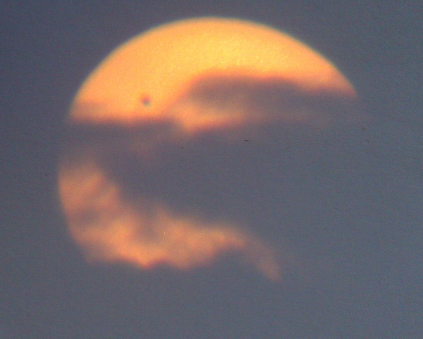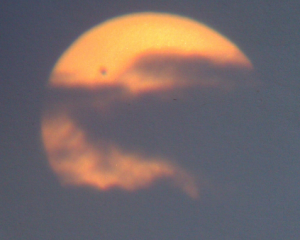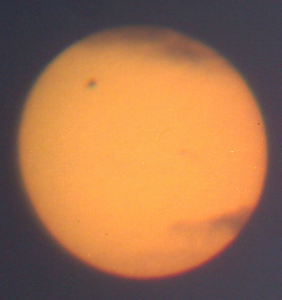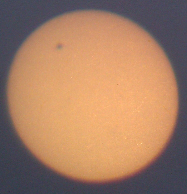So what is a transit anyway? A transit is when an object like an interior planet (one closer to the sun than the Earth) crosses in front of the sun that is visible to the Earth. This is one of the ways we can spot planets around other stars too. If we can watch the star long enough, we might see a dip in the star’s intensity, which might mean a planet got between us and that star. In fact, by looking at the different wavelengths of light we receive during one of these dips of intensity, we can determine the components of the atmosphere of that planet! Science is amazing right!?
Anyway, back to the phenomena at hand; the transit of Venus…Firstly, it is important to note that this event has only happened like 8 times since the invention of the telescope. You would assume that since Earth and Venus are close to one another that we would see Venus crossing the sun every year, but the model of the solar system you learn in school isn’t quite true. Usually students are taught that the planets travel in circular orbits around the sun in a similar manner as the rings of Saturn, all in the same plane. The truth is that the orbits are elliptical instead of circular and each planet is on its own plane. In fact, even the orbit of Earth’s moon doesn’t fall in the same plane as Earth (It is off by about 5 degrees. If it weren’t, we would have 1 solar and 1 lunar eclipse each month.)
The planes of Earth and Venus only overlap in such a way that the transit of Venus across the sun is only visible once every 100-some-odd years. (Well, technically, it happens twice every 100-some-odd years, but these two events are only a few years apart from one another). The history of the transit is enthralling, especially the story of the pair of transits in the 1760s.
Well, I’ve been getting more and more interested in astronomy and I was determined that I was going to catch the transit of Venus if I could. For months it had been marked on my calendar. The day of the event, June 5th, 2012, was overcast. I had forgotten to get a set of binoculars. I planned on making a simple solar projector. Basically, to do this, you point the binoculars at the sun (NEVER LOOK INTO THEM WITH YOUR EYESBALLS UNLESS REALLY HATE YOUR EYEBALLS AND PLAN TO BE BLIND FOR THE REST OF YOUR LIFE!!!) When they are aligned correctly, you can see a spot on the ground behind the binoculars. If you put a piece of paper behind the binoculars, you can see a perfect projection of the sun (sunspots included!).
Well, I had forgotten to get bincoulars, and the morning of the transit, I was scrambling last minute before leaving home in the morning to get to my lab at work to find somthing to cobble together to see this historic event. Then I had a sudden flash of insight. I could use my spotting scope from my LX-10 telescope! I didn’t have a way of mounting it to keep it steady, but I grabbed our broken camera tripod and a whole spaghetti-mess of bungie cords from the garage and threw them in my car. Just after 6pm (Eastern Standard time) the transit began. I attempted to project it, but couldn’t get anything in the lab. I then realized I was late for dinner.
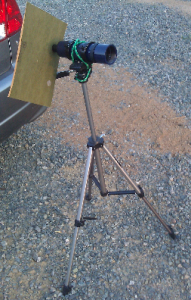
I was meeting Jessica for dinner at a restaurant near my school. I quickly rushed to meet her as she was already at a table waiting on me. When I got there, I even asked the waiter if we could change seats to be near the window. I brought my rigged up spotting scope in the restaurant and attempted to get a bead on Venus. I got quite a few odd looks from the other patrons, but I was on a mission! It had been cloudy all day, but at this point the clouds were spotty enough to provide clear views of the sun. I tried and tried to get a good projection, and I got a few really bad projections, but nothing that you could recognize as the transit. After dinner I nearly gave up.
On the way home, the sun was behind me. Jessica had gone ahead and called to tell me that the sun had already set behind a hill near my house, so if I was going to see the transit with my own eyes, I had better do it as soon as I could. I pulled over at the next parking lot I found and got out my kit to try again. I finally realized that the reason I wasn’t getting clear projections was that I was way out of focus. It finally struck me when I recognized the smeared rainbow pattern on my projection. The circle it projected wasn’t perfectly round, it bulged on the sides. One bulge was red and the other was blue. This is called a chromatic aberration and it’s the tell-tale sign of being badly out of focus. Then it hit me, of course it was out of focus; normally the spotting scope is set to project onto your eyeball a few centimeters from the eyepiece. I was trying to project the image on a piece of paper several feet away!
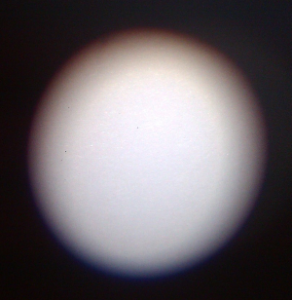
I refocused the spotting scope just in time to catch a cloud covering the area of the transit on the sun. Finally the clouds parted enough for me to get a couple of clear shots. I was so excited! You can clearly see Venus, as well as several sunspots. The only camera I had on me was my cell phone, so I took the best pictures I could, and even took a video. Check it out below the pics!
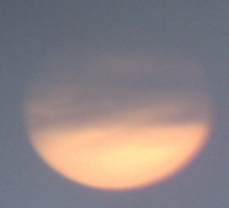
|
|
(There are no references in this post because I do science all day long, this blog is just for fun. Things written in this post are from memory)

